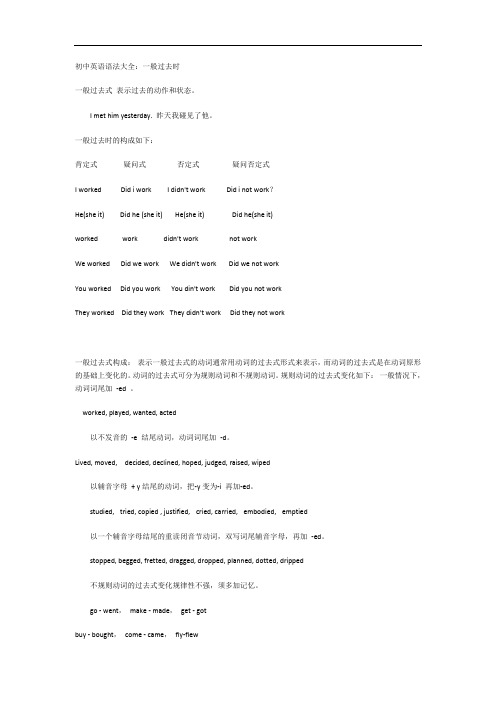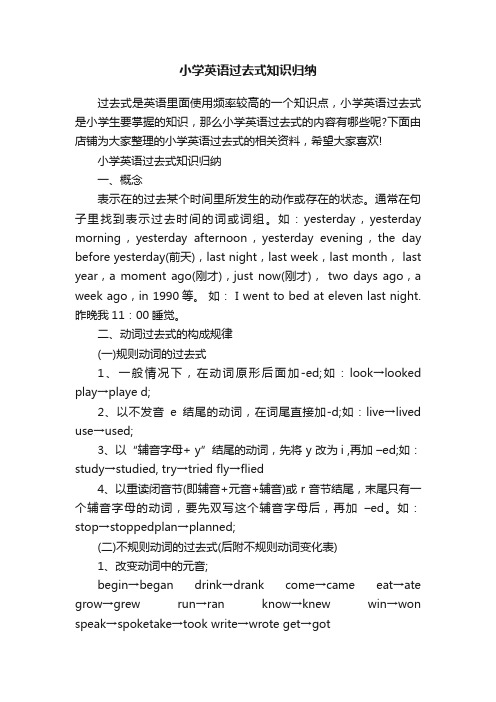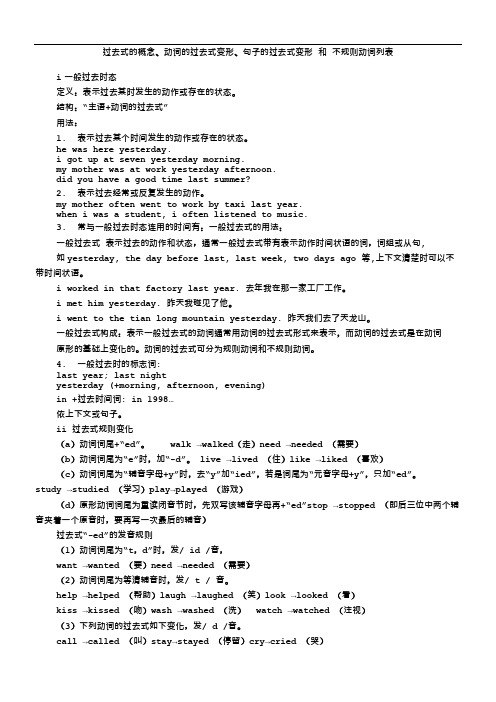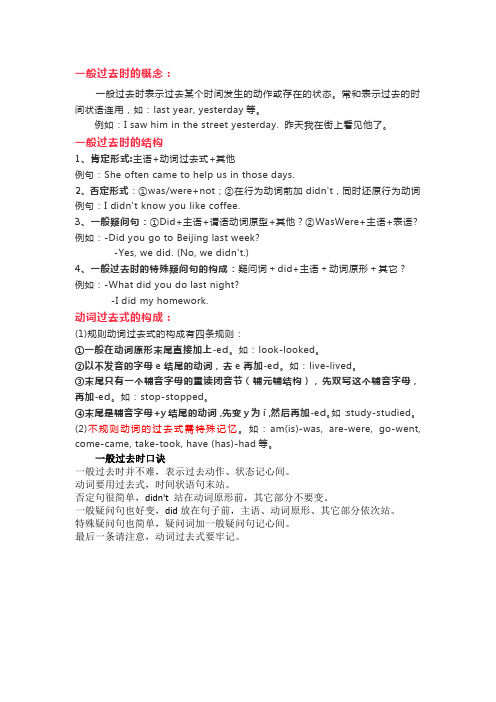英语过去式句子大全
初中英语语法大全:一般过去时

初中英语语法大全:一般过去时一般过去式表示过去的动作和状态。
I met him yesterday. 昨天我碰见了他。
一般过去时的构成如下:肯定式疑问式否定式疑问否定式I worked Did i work I didn't work Did i not work?He(she it) Did he (she it) He(she it) Did he(she it)worked work didn't work not workWe worked Did we work We didn't work Did we not workYou worked Did you work You din't work Did you not workThey worked Did they work They didn't work Did they not work一般过去式构成:表示一般过去式的动词通常用动词的过去式形式来表示,而动词的过去式是在动词原形的基础上变化的。
动词的过去式可分为规则动词和不规则动词。
规则动词的过去式变化如下:一般情况下,动词词尾加-ed 。
worked, played, wanted, acted以不发音的-e 结尾动词,动词词尾加-d。
Lived, moved,decided, declined, hoped, judged, raised, wiped以辅音字母+ y结尾的动词,把-y变为-i 再加-ed。
studied, tried, copied , justified, cried, carried, embodied, emptied以一个辅音字母结尾的重读闭音节动词,双写词尾辅音字母,再加-ed。
stopped, begged, fretted, dragged, dropped, planned, dotted, dripped不规则动词的过去式变化规律性不强,须多加记忆。
英语一般过去时的用法大全及答案解析

英语一般过去时的用法大全及答案解析一、初中英语一般过去时1.My mind wasn't on what he was saying so I'm afraid I ____________ half of it.A. missedB. was missingC. will missD. would miss【答案】A【解析】【分析】句意:本题翻译为:我的心思不在他刚才所说的内容上,所以我担心我刚才错过了一半的内容。
A. missed一般过去时;B. was missing过去进行时C. will miss一般将来时;D. would miss过去将来时。
根据句意,可知表示过去错过了一半的内容,所以用一般过去时,故选A。
【点评】此题考查一般过去时的用法。
2.Bella, a young singer, ______ on January, 2015 because of cancer. Her death made us very sad.A. has been deadB. has diedC. was deadD. died【答案】 D【解析】【分析】句意:贝拉,一位年轻的歌手在2015年的1月因为癌症去世了。
她的死叫我们很难过。
根据时间on January, 2015可知用过去式,结合句意和语境应选D。
3.Jake _____his key in the office so he had to wait until his wife _______ home.A. has forgotten … comesB. forgot… comeC. had left… cameD. had left…would come【答案】 C【解析】【分析】句意:杰克把他的钥匙丢在办公室了,因此他不得不等到他的妻子回家。
结合语境可知前文描述的是过去某时前已经完成的动作,故用过去完成时态。
下文指的是过去某时的动作,故用一般过去时态。
(完整版)英语一般过去时和过去进行时

一、一般过去时 (一) 一般过去时时态(1) 主要用来表示过去某一时间发生的(和现在没有联系的)动作或所处的状态,常有一个表示明确的过去的时间状语 ,如:the day before yesterday, yesterday, last week, three days ago, justnow, at that time , in 1999等;或跟由while/when 等引导的表示过去的时间状语从句; 或有上下文暗示动作发生的时间是在过去① They were in Paris three years ago. 三年前他们在巴黎② When I was at college, I spoke three foreign Ianguages.上大学的时候,我讲三门外语。
③ Have you seen a pen? I left here this morning,你看见一支笔了吗?今天早上我这的。
Is it ablack on e? I thi nk I saw it somewhere. 是黑色的吗?我想我在什么地方见到过。
(2) 表示过去经常或反复发生的动作。
① He always got up late on Sundays.周日他总是很晚才起床。
(3 )表示客气,与过去式无关,一般用在情态动词中① Would/Could you please give me a ha nd ? 你能帮我一下吗?(二) 谓语构成一般过去时的谓语不管主语的人称和单复数都用动词的过去式表示, 动词的过去式有规则与不规则两种。
规则动词的过去式在动词原形后加 -ed,不规则动词的过去式要逐个记忆。
规则动词的过去式变化方式如下:不规则动词的过去式 (举例)begin 宀 began go went see saw do did get got comecameleave left am was arewere give thought(三)一般过去时的否定式和疑问式(1)实义动词的一般过去时的否定式和疑问式要用助动词 did 帮助构成。
一般过去时的规则及例句

一般过去时的规则及例句一般过去时是英语中用来表示过去发生的动作或者状态的时态。
在使用一般过去时时,动词一般要变为其过去式形式,同时也要注意句子中的时间标志词。
一、一般过去时的构成规则1. 一般情况下,动词的过去式是在词尾加上“-ed”,比如:walk → walked,talk → talked。
2. 以不发音的“e”结尾的动词,在词尾只需加上“-d”,比如:live → lived,love → loved。
3. 以辅音字母+y结尾的动词,将“y”变为“i”,再加上“-ed”,比如:study → studied,carry → carried。
4. 以重读闭音节结尾并且末尾只有一个辅音字母的动词,双写末尾的辅音字母再加上“-ed”,比如:stop → stopped,plan → planned。
二、一般过去时的用法示例下面是一些例句来说明一般过去时的使用。
1. 表示过去某个时间发生的动作:- Last night, I watched a movie with my friends.- Yesterday, she visited her grandparents.2. 表示过去的习惯或经常性动作:- When I was young, I played soccer every weekend. - They always went to the beach for vacation.3. 表示过去的状态:- John was tired after work yesterday.- The weather was sunny during our vacation.4. 表示过去某个时间内持续的动作:- I lived in New York for five years.- They studied English for two hours yesterday.5. 过去式态势中的一般疑问句:- Did you see the movie last night?- Did they go to the party?6. 接受和拒绝的一般疑问句:- Did he agree to help us?- Did she refuse to go with them?7. 过去式态势中的否定句:- I didn't eat breakfast this morning.- They didn't finish their homework.三、注意事项1. 一般过去时常与过去的时间状语连用,如:yesterday(昨天)、last week(上周)、in 1990(在1990年)等。
四年级英语动词过去式练习30道

四年级英语动词过去式练习30道1. I ______ (go) to the park yesterday. 答案:went 解析:go 的过去式是went,yesterday 是过去的时间,要用过去式。
2. She ______ (eat) an apple last night. 答案:ate 解析:eat 的过去式是ate,last night 表示过去。
3. They ______ (play) football on Sunday. 答案:played 解析:play 的过去式是played,描述过去发生的动作。
4. He ______ (watch) TV yesterday evening. 答案:watched 解析:watch 的过去式是watched,yesterday evening 是过去时间。
5. We ______ (see) a movie last week. 答案:saw 解析:see 的过去式是saw,last week 表明过去的时间。
6. I ______ (play) football with my friends yesterday. 答案:played 解析:yesterday 是过去的时间,play 的过去式是played。
7. We ______ (study) hard for the test last week. 答案:studied 解析:last week 表示过去,study 的过去式是studied。
8. She ______ (dance) beautifully at the school party. 答案:danced 解析:at the school party 表明是过去发生的,dance 的过去式是danced。
9. They ______ (sing) songs happily in the music class. 答案:sang 解析:无明显标志词,但根据语境是过去的动作,sing 的过去式是sang。
22年中考英语语法:动词的过去式

This is Tom’s room last Sunday.
was wasn’t were weren’t
3/12 The calendar _______ next to the clock.
This is Tom’s room last Sunday.
was wasn’t were weren’t
4/12
The pizza _______ on the table.
This is Tom’s room last Sunday.
was wasn’t were weren’t
5/12 The boots _______ behind the armchair.
时间状语
助动词和情态动词 助动词和情态动词过去式如下: shall―should(将要)用于第一人称单数 will―would(将要)用于所有人称 can-could(能,会) may―might(可以) must―must (必须) have to―had to(不得不) 助动词和情态动词的过去时态要使用他们的过去式,后面的动词还使用原形。 如:I had to do my homework yesterday. (昨天我不得不做作业。)
【技巧2】当句中含有系动词was,were 时,可直接在其后加not构成否定句。
例如: I was on the Internet when you called me. → I was not / wasn't on the Internet when you called me.
【技巧3】当句中谓语是除情态动词、助动词、系动词was,were以外的动词时,在该 动词之前加did not / didn't,动词还原,构成否定句。
小学英语过去式知识归纳

小学英语过去式知识归纳过去式是英语里面使用频率较高的一个知识点,小学英语过去式是小学生要掌握的知识,那么小学英语过去式的内容有哪些呢?下面由店铺为大家整理的小学英语过去式的相关资料,希望大家喜欢!小学英语过去式知识归纳一、概念表示在的过去某个时间里所发生的动作或存在的状态。
通常在句子里找到表示过去时间的词或词组。
如:yesterday,yesterday morning,yesterday afternoon,yesterday evening,the day before yesterday(前天),last night,last week,last month, last year,a moment ago(刚才),just now(刚才),two days ago,a week ago,in 1990等。
如: I went to bed at eleven last night. 昨晚我11:00睡觉。
二、动词过去式的构成规律(一)规则动词的过去式1、一般情况下,在动词原形后面加-ed;如:look→looked play→playe d;2、以不发音e结尾的动词,在词尾直接加-d;如:live→lived use→used;3、以“辅音字母+ y”结尾的动词,先将 y 改为i ,再加–ed;如:study→studied, try→tried fly→flied4、以重读闭音节(即辅音+元音+辅音)或r音节结尾,末尾只有一个辅音字母的动词,要先双写这个辅音字母后,再加–ed。
如:stop→stoppedplan→planned;(二)不规则动词的过去式(后附不规则动词变化表)1、改变动词中的元音;begin→began drink→drank come→came eat→ate grow→grew run→ran know→knew win→won speak→spoketake→took write→wrote get→got2、变词尾的–d 为–t ; build→built lend→lent send→sent spend→spent bend→bent3、与动词原形一样; cut→cut put→put cost→cost hurt→hurt shut→shut4、变-ay 为-aid (少数动词); say→said pay→paid lay→laid5、采用不同词根;sell→sold teach→taught buy→bought6、其他。
英语过去式句子大全

过去式的概念、动词的过去式变形、句子的过去式变形和不规则动词列表i一般过去时态定义:表示过去某时发生的动作或存在的状态。
结构:“主语+动词的过去式”用法:1.表示过去某个时间发生的动作或存在的状态。
he was here yesterday.i got up at seven yesterday morning.my mother was at work yesterday afternoon.did you have a good time last summer?2.表示过去经常或反复发生的动作。
my mother often went to work by taxi last year.when i was a student, i often listened to music.3.常与一般过去时态连用的时间有:一般过去式的用法:一般过去式表示过去的动作和状态,通常一般过去式带有表示动作时间状语的词,词组或从句,如yesterday, the day before last, last week, two days ago 等,上下文清楚时可以不带时间状语。
i worked in that factory last year. 去年我在那一家工厂工作。
i met him yesterday. 昨天我碰见了他。
i went to the tian long mountain yesterday. 昨天我们去了天龙山。
一般过去式构成:表示一般过去式的动词通常用动词的过去式形式来表示,而动词的过去式是在动词原形的基础上变化的。
动词的过去式可分为规则动词和不规则动词。
4.一般过去时的标志词:last year; last nightyesterday (+morning, afternoon, evening)in +过去时间词: in 1998…依上下文或句子。
ii 过去式规则变化(a)动词词尾+“ed”。
英语 常见动词过去式

英语常见动词过去式:1. am,is -was2. are--were3. 击败;敲打beat--beat4. 成为/变成become--became5. 开始begin--began6. 吹;刮blow--blew7. 折断;打破break--broke8. 带来bring--brought9. 建设;建造build--built10. 买buy--bought11. 能,能够can--could12. 抓/捉住;乘车catch-cought13. 选择;选choose--chose14. 来come--came15. 值cost--cost16. 切;割;砍cut-cut-17. 做do--did18. 绘画;画draw--drew19. 喝drink--drank20. 驾驶drive--drove21. 吃eat--ate22. 掉下;降落fall--fell23. 感到;感觉feel--felt24. 发现;找到find--found25. 飞fly--flew26. 忘记forget-forgot27. 取;获得get--got28. 给give--gave29. 去;走go--went30. 种植;成长grow--grew31. 有/吃have/has--had32. 听见hear--heard33. 保持keep--kept34. 知道;认识know--knew35. 学习;学会learn-learnt/learned36. 离开;落下leave--left37. 借出/给lend— lent38. 让let--let39. 位于lie--lay40. 丢失lose--lost41. 可以may--might42. 意味;意思mean---meant43. 遇见/到meet--met44. 放put--put45. 读read --read注意读法不同/e/46. 骑ride--rode47. 铃响ring--rang48. 跑run--ran49. 说say--said50. 看见;看望see--saw51. 卖sell--selt52. 送send--sent53. 将;应该shall--should54. 照耀shine--shone55. 唱sing--sang56. 坐sit--sat57. 睡觉sleep--slept58. 闻;嗅smell--smelt59. 说;讲speak--spoke60. 花费;度过spend--spent61. 站stand--stood62. 扫;拖地sweep--swept63. 游泳swim--swam64. 拿走;带走take --took65. 教teach--taught66. 告诉;讲tell--told67. 想;认为think--thought68. 扔;掷throw--threw69. 理解/明白understand--understood70. 醒wake--woke71. 穿;戴wear--wore72. 将;愿will--would73. 赢得;战胜win--won74. 写write—wrote形容词副词第一、变化规则一、在形容词词尾直接加-ly。
英语常见动词过去式

英语常见动词过去式:1. am,is -was2. are--were3. 击败;敲打beat--beat4. 成为/变成become--became5. 开始begin--began6. 吹;刮blow--blew7. 折断;打破break--broke8. 带来bring--brought9. 建设;建造build--built10. 买buy--bought11. 能,能够can--could12. 抓/捉住;乘车catch-cought13. 选择;选choose--chose14. 来come--came15. 值cost--cost16. 切;割;砍cut-cut-17. 做do--did18. 绘画;画draw--drew19. 喝drink--drank20. 驾驶drive--drove21. 吃eat--ate22. 掉下;降落fall--fell23. 感到;感觉feel--felt24. 发现;找到find--found25. 飞fly--flew26. 忘记forget-forgot27. 取;获得get--got28. 给give--gave29. 去;走go--went30. 种植;成长grow--grew31. 有/吃have/has--had32. 听见hear--heard33. 保持keep--kept34. 知道;认识know--knew35. 学习;学会learn-learnt/learned36. 离开;落下leave--left37. 借出/给lend— lent38. 让let--let39. 位于lie--lay40. 丢失lose--lost41. 可以may--might42. 意味;意思mean---meant43. 遇见/到meet--met44. 放put--put45. 读read --read注意读法不同/e/46. 骑ride--rode47. 铃响ring--rang48. 跑run--ran49. 说say--said50. 看见;看望see--saw51. 卖sell--selt52. 送send--sent53. 将;应该shall--should54. 照耀shine--shone55. 唱sing--sang56. 坐sit--sat57. 睡觉sleep--slept58. 闻;嗅smell--smelt59. 说;讲speak--spoke60. 花费;度过spend--spent61. 站stand--stood62. 扫;拖地sweep--swept63. 游泳swim--swam64. 拿走;带走take --took65. 教teach--taught66. 告诉;讲tell--told67. 想;认为think--thought68. 扔;掷throw--threw69. 理解/明白understand--understood70. 醒wake--woke71. 穿;戴wear--wore72. 将;愿will--would73. 赢得;战胜win--won74. 写write—wrote形容词副词第一、变化规则一、在形容词词尾直接加-ly。
过去式的英语练习题

过去式的英语练习题过去式(Past Tense)是英语中表示过去发生的动作或状态的时态。
掌握过去式的用法对于英语学习者来说非常重要。
本文将提供一些过去式的英语练习题,帮助读者巩固记忆和提高运用能力。
Exercise 1:根据括号中的提示动词,完成下列句子的过去式。
1. He (buy) a new car yesterday.2. They (go) to the park last week.3. The dog (bark) loudly in the middle of the night.4. She (read) that book last month.5. We (watch) a movie together yesterday evening.6. I (eat) lunch at a restaurant earlier today.7. He (dance) at the party last night.8. The teacher (teach) a new lesson in class yesterday.9. They (play) soccer in the park yesterday afternoon.10. She (write) a letter to her friend last week.Exercise 2:选择正确的动词形式填空。
1. I _______ (visit / visited) my grandparents yesterday.2. They _______ (talk / talked) about their vacation last night.3. We _______ (watch / watched) a movie at home yesterday evening.4. He _______ (clean / cleaned) his room yesterday morning.5. The students _______ (study / studied) for the exam last week.6. She _______ (arrive / arrived) at the airport an hour ago.7. The cat _______ (jump / jumped) off the table yesterday.8. They _______ (invite / invited) their friends to the party last month.9. The flowers _______ (bloom / bloomed) beautifully in the garden.10. I _______ (finish / finished) my homework a few minutes ago. Exercise 3:根据图片描述过去发生的事情,填写对应的过去式动词。
小学英语过去式讲解(附练习及答案)

一般过去时的概念:一般过去时表示过去某个时间发生的动作或存在的状态。
常和表示过去的时间状语连用,如:last year, yesterday等。
例如:I saw him in the street yesterday. 昨天我在街上看见他了。
一般过去时的结构1、肯定形式:主语+动词过去式+其他例句:She often came to help us in those days.2、否定形式:①was/were+not;②在行为动词前加didn't,同时还原行为动词例句:I didn't know you like coffee.3、一般疑问句:①Did+主语+谓语动词原型+其他?②WasWere+主语+表语?例如:-Did you go to Beijing last week?-Yes, we did. (No, we didn't.)4、一般过去时的特殊疑问句的构成:疑问词+did+主语+动词原形+其它?例如:-What did you do last night?-I did my homework.动词过去式的构成:(1)规则动词过去式的构成有四条规则:①一般在动词原形末尾直接加上-ed。
如:look-looked。
②以不发音的字母e结尾的动词,去e再加-ed。
如:live-lived。
③末尾只有一个辅音字母的重读闭音节(辅元辅结构),先双写这个辅音字母,再加-ed。
如:stop-stopped。
④末尾是辅音字母+y结尾的动词,先变y为i,然后再加-ed。
如:study-studied。
(2)不规则动词的过去式需特殊记忆。
如:am(is)-was, are-were, go-went, come-came, take-took, have (has)-had等。
一般过去时口诀一般过去时并不难,表示过去动作、状态记心间。
动词要用过去式,时间状语句末站。
否定句很简单,didn't 站在动词原形前,其它部分不要变。
过去式句子大全

过去式句子大全过去式是英语中表示过去时间的一种动词形式,它有着非常重要的作用。
在英语中,过去式的构成有规律可循,但也存在一些不规则动词需要特别记忆。
下面将为大家总结一些常见的过去式句子,希望能够帮助大家更好地掌握和运用过去式。
1. 我昨天去了图书馆。
I went to the library yesterday.2. 她小时候常常去公园玩。
She often went to the park when she was a child.3. 我们上周去了一趟海边。
We went to the seaside last week.4. 他昨天晚上做了一顿美味的晚餐。
He cooked a delicious dinner last night.5. 我们去年去了巴黎旅行。
We traveled to Paris last year.6. 她小时候看了很多经典的动画片。
She watched a lot of classic cartoons when she was young.7. 我们在学校学习了很多有趣的知识。
We learned a lot of interesting knowledge at school.8. 他们上个月举办了一场盛大的婚礼。
They held a grand wedding last month.9. 我昨天买了一件漂亮的连衣裙。
I bought a beautiful dress yesterday.10. 我们去年夏天度过了一个难忘的假期。
We had an unforgettable holiday last summer.11. 她小时候喜欢画画。
She liked drawing when she was young.12. 我们昨天晚上去了一家新开的餐厅。
We went to a newly opened restaurant last night.13. 他小时候读了很多经典的小说。
一般过去式与过去进行时英语语法

一般过去式与过去进行时构成:主+was/were或者主+动词过去式I was very surprised when the Alien went into a toy shop. ......我很惊讶The Alien was so cute 外星人很可爱We were on the playground when the UFO landed. 我们在操场上When the police arrived; the Alien disappeared suddenly.be动词在一般过去时中表示“是”、“在”有意义基本构成:was/were +doingWe were playing football when the UFO landedI was eating an apple when the UFO landedI was reading a book when the UFO landedbe动词在过去进行时中只是一个符号;无意义一般过去时的用法1、表示过去某个时间发生的动作或存在的状态..He was at home yesterday.I got up at six thirty yesterday morning.I visited my aunt last weekend.2、表示过去经常或反复发生的动作..My father often went to work by bus last year.When I was a child; I often listened to music.He always carried an umbrella.常与一般过去时态连用的时间有:①yesterday; yesterday morning; the day before yesterday②last night last week; last month; last year…③two days ago; three years ago…a moment ago=just now刚才④in 1990; in 1998…⑤this morning; this Monday⑥When I was 5 years old过去进行时的用法:一、过去进行时常表示过去某一时刻或过去某一阶段内正在进行的动作..过去某一时刻1.昨天的这个时候我正在做作业..I was doing my homework at this time yesterday.过去某一阶段内2.昨晚我一直在作业..I was doing my homework last night.二、过去进行时可描述故事发生的背景..一个长动作发生的时候;另一个短动作突然发生..长动作延续性动词用过去进行时;短动作点动词用一般过去时..当两种时态用于同一个句子时;过去进行时描述故事发生的背景;过去时报道该事件..When my mother came back; I was watching TV.when + 一般过去时;过去进行时I was watching TV when my mother came back.过去进行时 ; when + 一般过去时三、过去进行时可表示两个动作同时进行;有时含“对比”的含义..过去进行时 + while +过去进行时When I was watching TV; my mother was cooking.当我在看电视时;我母亲在做饭..注:两个动作同时发生;并且都是长动作延续性动词时;才能都用过去进行时 ..四、过去进行时常与always;forever等连用;表示厌恶;埋怨;表扬;喜爱等感情色彩..My father was always smoking when he was young.埋怨She was always thinking of others. 表扬She was forever complaining. 厌恶注:下列几类动词通常不用过去进行时..①表示状态的动词be;②感官动词:feel;hear;see;smell;taste等;③表示思维或心理状态的动词:believe认为;forget;consider考虑认为;know;understand;remember;hope;wish;want等;④表示所属关系的动词:belong属于;have;own拥有;hold容纳等过去进行时与一般过去时的区别过去进行时着重描述当时正在持续进行的动作;强调过程;一般过去时表示发生过的动作或存在的状态;即表示动作发生过;或者已经结束了;强调事实或结果..She wrote a letter to her friend last night.她昨晚给她的朋友写了封信信写完了She was writing a letter to her friend last night.她昨晚一直在给她的朋友写信..信不一定写完翻译练习:1.昨天上午7点你在做什么2.有一天当他在河边散步的时候;刚好看见有人自杀commit suicide3.我们正在下棋;突然电话响了..4.当你回来时;他在看电视吗5.昨晚我在看电视;我的父亲在看书..Linda loves her dog Davy. They went to New York City last Saturday. While Linda was buying a newspaper at the train station; the dog got out of his box and ran away. The station was crowded and Linda couldn't see Davy anywhere. When Linda shouted his name; some peoplelooked at her but Davy didn't come. Then she called the police. While she was talking on the telephone; Davy met another dog outside the station. While the police were coming; Linda walked around the station and called Davy' s name. She didn't think about looking outside the station. Finally; a little boy said to her; "Did you look outside I saw a big black dog when I came in. "When Linda finally saw Davy; he was jumping and running with another dog. There was a police officer next to them. The police officer said to Linda; "I think my dog found your dog."46. What was Linda doing when Davy ran away47. How was the station48. What did Linda do when she couldn't find her dog49.What did Linda do when the police were coming50. What was Davy doing when Linda saw itLang Lang was born in 1982 in Shenyang; China. He watch a Tom and Jerry cartoon on television when he first hear Western classical music. He be only two years old then. Lang Lang begin taking piano lessons at the age of three. He won many awards he was young.However; Lang Lang's success came at a price. His father bevery strict with him. He practice the piano while other children of his age play games and having fun . In Beijing; Lang Lang enter the finest music academy in China.At the age of just 17; Lang Lang got his big chance. In August 1999; at a famous musical event in the USA; a pianist suddenly fell ill. Lang Lang was chosen to play in place of that pianist. It was a great success and Lang Lang's life change forever.。
英语动词过去式大全 -回复

英语动词过去式大全一、规则动词的过去式变化如下:1、一般情况下,动词词尾加-ed:如:work-worked play-played wanted-wanted act-acted2、以不发音的-e结尾动词,动词词尾加-d:如:live-lived move-moved taste-tasted hope-hoped3、以辅音字母+y结尾的动词,把-y变为-i再加-ed:如:study-studied copy-copied cry-cried carry-carried4、以一个辅音字母结尾的重读闭音节动词,双写词尾辅音字母,再加-ed:如:stop-stopped5、不规则动词的过去式变化规律性不强,须多加记忆。
如:go-went make-made get-got buy-bought come-came fly-flew二、不规则动词的过去式的构成:1、把动词原形中的i改为a,变成过去式。
如:begin—began,drink—drank,give—gave,ring—rang,sing—sang,sit—sat,swim—swam2、把重读开音节中的i改为o,变成过去式。
如:drive—drove,ride—rode,write—wrote3、改动词原形中的aw/ow为ew,变成过去式。
如:draw—drew,grow—grew,know—knew,throw—threw (动词show除外,show—showed)4、动词原形中的e改为o,变成过去式。
如:get—got,forget—forgot5、动词原形中的ee改为e,变成过去式。
如:feed—fed,meet—met6、动词原形中的eep改为ept,变成过去式。
如keep—kept,sleep—slept,sweep—swept7、动词原形中的eak改为oke,变成过去式。
如:break—broke,speak—spoke8、动词原形中的ell改为old,变成过去式。
一般过去时的句子

一般过去时的句子一般过去时是英语中最基本的时态之一,用来描述过去发生的事情、习惯或状态。
在一般过去时的句子中,动词通常要加上-ed 结尾,但也有一些不规则动词需要特别记忆。
下面我们来详细了解一般过去时的句子结构和用法。
一般过去时的肯定句结构是,主语 + 动词过去式 + 其他。
例如:I watched a movie yesterday.(昨天我看了一部电影。
)。
She played basketball last week.(她上周打篮球。
)。
在一般过去时的句子中,动词过去式的变化规则是:一般情况下,在动词原形后加-ed。
例如,watched, played。
以不发音的e结尾的动词,只加-d。
例如,liked, danced。
以辅音字母+y结尾的动词,变y为i再加-ed。
例如,studied, tried。
另外,一般过去时也有一些不规则动词,它们的过去式需要特别记忆,比如:go的过去式是went。
eat的过去式是ate。
have的过去式是had。
一般过去时的否定句结构是,主语 + did not + 动词原形 +其他。
例如:I did not watch a movie yesterday.(昨天我没有看电影。
)。
She did not play basketball last week.(她上周没有打篮球。
)。
一般过去时的疑问句结构是,Did + 主语 + 动词原形 + 其他?例如:Did you watch a movie yesterday?(昨天你看了电影吗?)。
Did she play basketball last week?(她上周打篮球了吗?)。
在一般过去时的句子中,我们还需要注意一些时间状语的使用,比如yesterday(昨天)、last week(上周)、two days ago(两天前)等,它们可以帮助我们更清楚地表达动作发生的时间。
另外,一般过去时也可以用来描述过去的习惯或状态,比如:She used to play the piano when she was young.(她年轻的时候常常弹钢琴。
小学英语句型和过去式

Class Name
I. 一般疑问句
用be动词(is / am / are),助动词do/did/does、have/ has、will, 情态动词can提问的问句。
通常用Yes 和No回答。
II. 特殊疑问句:用疑问词what(什么), where(哪里), who(谁), whose(谁的),when(什么时候), how(怎样), which(哪一个)提问的问句。
Sentences (句子)
Sentences (句子)
Sentences (句子)
Sentences (句子)
Sentences (句子)
Sentences (句子)
Sentences (句子)
Sentences (句子)
Sentences (句子)
句子)
Sentences (
III. 动词过去式
1. 过去时由动词的过去式表示,多数动词的过去式是在动词后加ed,这类动词称为规则动词。
2. 不规则动词原形与过去式
3. 动词过去式的否定式
动词过去式的否定式是在动词之前加didn’t, 动词变原形。
六年级英语重点单词过去式

六年级英语重点单词过去式过去式(Past tense)是英语语法中的一个重要概念。
在六年级英语学习中,学生们需要掌握一系列常见动词的过去式形式。
过去式是表示过去发生的动作、事情或状态的形式。
以下将详细介绍几个常见的六年级英语重点单词的过去式形式。
1. go – went"go"意思是“去”。
它的过去式形式是"went"。
例如:I went to the park yesterday.(我昨天去了公园。
)2. eat – ate"eat"意思是“吃”。
它的过去式形式是"ate"。
例如:She ate an apple for breakfast.(她早餐吃了一个苹果。
)3. drink – drank"drink"意思是“喝”。
它的过去式形式是"drank"。
例如:They drank some waterafter playing soccer.(他们踢完足球后喝了些水。
)4. see – saw"see"意思是“看到”。
它的过去式形式是"saw"。
例如:He saw a bird in the tree.(他在树上看到了一只鸟。
)5. do – did"do"意思是“做”。
它的过去式形式是"did"。
例如:We did our homework together.(我们一起做作业。
)6. have – had"have"意思是“有”。
它的过去式形式是"had"。
例如:She had a great time at the party.(她在派对上过得很开心。
)7. make – made"make"意思是“制作”。
它的过去式形式是"made"。
- 1、下载文档前请自行甄别文档内容的完整性,平台不提供额外的编辑、内容补充、找答案等附加服务。
- 2、"仅部分预览"的文档,不可在线预览部分如存在完整性等问题,可反馈申请退款(可完整预览的文档不适用该条件!)。
- 3、如文档侵犯您的权益,请联系客服反馈,我们会尽快为您处理(人工客服工作时间:9:00-18:30)。
过去式的概念、动词的过去式变形、句子的过去式变形和不规则动词列表i一般过去时态定义:表示过去某时发生的动作或存在的状态。
结构:“主语+动词的过去式”用法:1.表示过去某个时间发生的动作或存在的状态。
he was here yesterday.i got up at seven yesterday morning. my mother was at work yesterday afternoon. did you have a good time last summer?2.表示过去经常或反复发生的动作。
my mother often went to work by taxi last year. when i was a student, i often listened to music.3. 常与一般过去时态连用的时间有:一般过去式的用法:一般过去式表示过去的动作和状态,通常一般过去式带有表示动作时间状语的词,词组或从句,如yesterday, the day before last, last week, two days ago 等,上下文清楚时可以不带时间状语。
i worked in that factory last year. 去年我在那一家工厂工作。
i met him yesterday. 昨天我碰见了他。
i went to the tian long mountain yesterday. 昨天我们去了天龙山。
一般过去式构成:表示一般过去式的动词通常用动词的过去式形式来表示,而动词的过去式是在动词原形的基础上变化的。
动词的过去式可分为规则动词和不规则动词。
4. 一般过去时的标志词:last year; last nightyesterday (+morning, afternoon, evening) in +过去时间词: in 1998…依上下文或句子。
ii 过去式规则变化(a)动词词尾+“ed”。
walk →walked(走)need →needed (需要)(b)动词词尾为“e”时,加“-d”。
live →lived (住)like →liked (喜欢)(c)动词词尾为“辅音字母+y”时,去“y”加“ied”,若是词尾为“元音字母+y”,只加“ed”。
study →studied (学习)play→played (游戏)(d)原形动词词尾为重读闭音节时,先双写该辅音字母再+“ed”stop →stopped (即后三位中两个辅音夹着一个原音时,要再写一次最后的辅音)过去式“-ed”的发音规则(1)动词词尾为“t,d”时,发/ id /音,want →wanted (要)need →needed (需要)(2)动词词尾为等清辅音时,发/ t / 音。
help →helped (帮助)laugh →laughed (笑)look →looked (看)kiss →kissed (吻)wash →washed (洗) watch →watched (注视)(3)下列动词的过去式如下变化,发/ d /音。
call →called (叫)stay→stayed (停留)cry→cried (哭)提示a. beat的过去式与原形同形:beat(打击) beat(过去式) beaten(过去分词)b. lie有规则变化和不规则变化两种,含义不同lie lied, lied(说谎)lie lay, lain(躺,位于)c. hang 有规则变化和不规则变化两种,含义不同hang hanged, hanged(处绞刑)hang hung, hung(挂,吊)e.不要将不规则动词误用为规则动词hit(打) hit(正)hit (打) hitted(误)过去式的句型转化:1.be 动词的过去时的句型如下:(1)否定句:主语 + be动词的过去式(was, were)+ not…(2)疑问句: be动词的过去式(was, were)+ 主语…?a.he was busy yesterday. (肯定句) 他昨天很忙。
b.he was not busy yesterday. (否定句) 他昨天不忙。
c.was he busy yesterday? (疑问句) 他昨天忙吗?d.there weren’t any boys in the room.房间里没有男孩儿。
e. were there any boys in the room? 房间里有男孩儿吗?2.行为动词的否定式和疑问式:(1)若肯定句中只有一个行为动词,那就得在行为动词前加上did not或缩略式didn’t,并把这个行为动词由过去式改为动词原形。
例如:a. i called lin tao yesterday afternoon. →i did not / didn’t call lin taoyesterday afternoon.b. i borrowed a book from sun yang last sunday. → i didn’t borrow a book fromsun yang last sunday.(2) 行为动词的一般疑问句若在述句中只有行为动词的过去式,那就得在句首加上一个助动词did来帮助提问,然后把句中的行为动词由过去式改为动词原形,并在句末打上问号。
回答时别忘了还用did.例如:a. we stayed there for 10 days last month. → did you stay there for 10 days lastmonth? yes, we did. / no, we didn’t.b. mary had a delicious dinner yesterday evening. → did mary have a deliciousdinner yesterday evening? yes, she did. / no, she didn’t 1. aaa型(原形、过去式和过去分词同形):cost cost costcut cut cutlet let letput put putread read read 2. abb型(过去式与过去分词同形):bring brought broughtbuild built builtcatch caught caughtdig dug dugfeel felt feltfind found foundget got gothave had hadhear heard heardhold held heldkeep kept kept ※learn learnt learntleave left left lend lent lentmake made mademeet met metpay paid paidsay said saidsell sold soldsend sent sentshine shone shonesit sat satsleep slept slept ※smell smelt smeltspend spent spentstand stood stoodteach taught taughttell told toldthink thought thoughtunderstand understoodunderstood3. abc型(原形、过去式和过去分词各异): be was/were been begin began begunblow blew blownbreak broke brokendo did donedraw drew drawndrink drank drunkdrive drove driveneat ate eatenfall fell fallenfly flew flownforget forgot forgottengive gave givengo went goneknow knew knownlie lay lainride rode riddenring rang rungsee saw seenshow showed shownsing sang sungspeak spoke spokenswim swam swumtake took takenthrow threw thrown wake woke wokenwear wore wornwrite wrote written5. aab型(原形与过去式同形): beat beat beaten篇二:动词过去式在四种句子的使用一般过去式的四种句式变化顺口溜:肯定句中动词要变化;否定句很简单,主语之后didnt 添,动词要还原;疑问句did 放在主语后,动词还是要还原。
篇三:过去式、句子成分和16种时态【过去式】1、表示过去某个时间里发生的动作或状态;2、过去习惯性、经常性的动作、行为;过去主语所具备的能力和性格。
【过去时态】表示行为、动作和状态在各种时间条件下的动词形式。
【过去时态结构】指的是过去时态下的动词形式的语法构成。
【过去时态结构基本形式】1、主语+动词过去式+其他;2、否定形式①was/were+not;②在行为动词前加didnt,同时还原行为动词;一般疑问句did+主语+do+其他。
概念:表示过去的动作或事件。
a:what did you do last weekend? b:i played football.a:did you read books?b:yes,i did.构成表示一般过去式的动词通常用动词的过去式形式来表示,而动词的过去式是在动词原形的基础上变化的。
动词的过去式可分为规则动词和不规则动词。
规则动词的过去式变化如下:(1)一般情况下,动词词尾加 ed ,如:worked played wanted acted (2)以不发音的 e 结尾动词,动词词尾加 d,如:lived moved decided declined hoped judged raised wiped (3)以辅音字母 + y结尾的动词,把y变为i 再加ed,如:studied tried copied justified cried carried embodied emptied (4)以一个辅音字母结尾的重读闭音节动词,双写词尾辅音字母,再加 ed,如:stopped begged fretted dragged dropped planned dotted dripped (5)注:不规则动词的过去式变化规律性不强,须多加记忆。
注意:a. beat的过去式与原形同形:比:beat(打击) beat(过去式) beaten(过去分词)b. lie有规则变化和不规则变化两种,含义不同比:lie lied, lied(说谎)lay, lain(躺,位于)c. hang 有规则变化和不规则变化两种,含义不同比:hang hanged, hanged(处绞刑)hung, hung(挂,吊)e.不要将不规则动词误用为规则动词比:hit(打) hit, hit(正)hitted, hitted(误)用法:(1)表示过去某一时刻或某一段时间所发生的动作或情况,通常一般过去式带有表示动作时间状语的词,词组或从句,如 yesterday, the day before last, last week, two days ago等,上下文清楚时可以不带时间状语。
